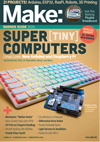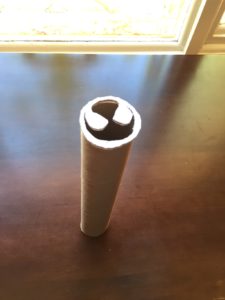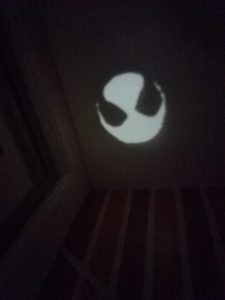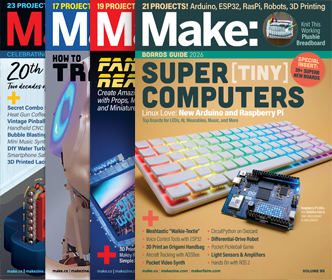
Penny-Powered Flashlight
WHAT WILL YOU MAKE?
Power a flashlight with pennies so you can signal Spider-Man when you’re in need! No store-bought batteries necessary. Build the flashlight with an LED and a few other household supplies, and make your own power source with coins and cardboard.
WHAT WILL YOU LEARN?
You will construct a device that uses the power of an electrochemical reaction to generate enough current to light an LED.
STEPS
STEP 1
Gather seven pennies that were made in 1983 or later. You can tell when a penny was made by looking at the date on the front of it. Pennies made in 1983 and later have zinc in them, which is what we need for this project.
STEP 2
Put on your safety glasses and sand one side of each penny until it has a silver-looking finish. That's the zinc! It could take a while to sand away the copper (brown finish), but the zinc is under there.
STEP 3
Place a penny on a piece of cardboard and trace around it six different times. Pour vinegar into the cup. Cut out the six cardboard circles and put them into the cup of vinegar.
Once they are completely saturated with vinegar, take the cardboard circles out and use a paper towel to wipe off the excess vinegar.
STEP 4
Now let's build the battery. Cut a piece of duct tape about 1/2" wide and 5" long. Lay it flat on a surface — sticky side up. Place 1 sanded penny — zinc (silvery) side up — in the middle of the tape.
STEP 5
Place a cardboard circle on top of the penny. Place another penny — zinc side up — on top of the cardboard circle. Continue to do this until you've placed all pennies and cardboard circles in one stack. A penny with the zinc side facing up should be at the top of the stack.
STEP 6
Bring one end of the duct tape up along the side of the stack, wrap it across the top, and then down along the other side to where it meets the other half. Wrap the second half of duct tape in the same way over the first, affixing it across the bottom of the stack and cutting off any excess tape. The other two sides of the stack should remain open so we can attach the LED.
WHAT'S HAPPENING HERE?
Batteries are devices that convert chemical energy into electrical energy. When two different metals are connected by an electrolyte, a chemical reaction occurs at each metal surface, called electrodes, that either releases or uses electrons. When these electrodes are connected by a wire, electrons will move from one surface to the other, creating an electric current.
Pennies that were made after 1982 have zinc cores that are plated with copper. By sanding off one face of a penny, you create a zinc electrode that can pair with the copper electrode on the face of the next penny. The matboard soaked in salty vinegar water serves as the electrolyte between the two terminals.
Each zinc-matboard-copper stack represents one individual cell. By stacking additional matboards and sanded pennies, you’ve created a battery, which is a series of electrochemical cells. This is also called a voltaic pile, which is named after Alessandro Volta, who created the first battery in 1800 by alternating zinc and copper electrodes with sulfuric acid between them. In Volta’s battery and your penny battery, an oxidation reaction occurs at the zinc electrode that releases electrons and a reduction reaction occurs at the copper electrode that uses them. From Exploratorium.
WHAT'S NEXT?
Tinker with light and shadow as you figure out how to construct an addition for your flashlight so you can see Spider-Man’s face in the beam of light! See our first prototype below. How might you add in fine structures to get the web-like features to show on Spider-Man’s face?
Can you make the flashlight image look more like Spidey’s face? Reference image here.
You can also increase the voltage by adding more pennies and cardboard circles to your stack. Use a multimeter to measure how much voltage your stack of pennies is creating and compare that to the label on the batteries in an inexpensive calculator. Run two wires from your penny-pack to the battery compartment of the calculator. Note where the positive and negative wires need to attach, and test how much voltage your penny battery puts out before trying to use it.
Materials:
- 7 pennies, made in 1983 or later
- Scrap cardboard, about 6" square
- Paper towels
- Paper or plastic cup
- Vinegar
- Duct tape, 5" piece
- LED, red
- Medium- or fine-grit sandpaper
- Scissors
- Pencil
- Safety glasses
See More Projects in these topics:
ElectronicsSee More Projects from these themes:
The Canteen (Mess Hall and Recycling Station)Maker Camp
Please Note
Your safety is your own responsibility, including proper use of equipment and safety gear, and determining whether you have adequate skill and experience. Power tools, electricity, and other resources used for these projects are dangerous, unless used properly and with adequate precautions, including safety gear and adult supervision. Some illustrative photos do not depict safety precautions or equipment, in order to show the project steps more clearly. Use of the instructions and suggestions found in Maker Camp is at your own risk. Make Community, LLC, disclaims all responsibility for any resulting damage, injury, or expense.
Maker Camp Project Standards
Based on NGSS (Next Generation Science Standards)
NGSS (Next Generation Science Standards)
The Next Generation Science Standards (NGSS) are K–12 science content standards. Learn more.Forces and Motion
- 3-PS2-3. Ask questions to determine cause and effect relationships of electric or magnetic interactions between two objects not in contact with each other.
- HS-PS4-5. Communicate technical information about how some technological devices use the principles of wave behavior and wave interactions with matter to transmit and capture information and energy.
NGSS 3-5.Engineering Design
The Next Generation Science Standards (NGSS) are K–12 science content standards.- 3-5-ETS1-1. Define a simple design problem reflecting a need or a want that includes specified criteria for success and constraints on materials, time, or cost.
- 3-5-ETS1-2. Generate and compare multiple possible solutions to a problem based on how well each is likely to meet the criteria and constraints of the problem.
- 3-5-ETS1-3. Plan and carry out fair tests in which variables are controlled and failure points are considered to identify aspects of a model or prototype that can be improved.
NGSS MS.Engineering Design
The Next Generation Science Standards (NGSS) are K–12 science content standards.- MS-ETS1-1. Define the criteria and constraints of a design problem with sufficient precision to ensure a successful solution, taking into account relevant scientific principles and potential impacts on people and the natural environment that may limit possible solutions.
- MS-ETS1-2. Evaluate competing design solutions using a systematic process to determine how well they meet the criteria and constraints of the problem.
- MS-ETS1-3. Analyze data from tests to determine similarities and differences among several design solutions to identify the best characteristics of each that can be combined into a new solution to better meet the criteria for success.
- MS-ETS1-4. Develop a model to generate data for iterative testing and modification of a proposed object, tool, or process such that an optimal design can be achieved.
NGSS HS.Engineering Design
The Next Generation Science Standards (NGSS) are K–12 science content standards.- HS-ETS1-1. Analyze a major global challenge to specify qualitative and quantitative criteria and constraints for solutions that account for societal needs and wants.
- HS-ETS1-2. Design a solution to a complex real-world problem by breaking it down into smaller, more manageable problems that can be solved through engineering.
- HS-ETS1-3. Evaluate a solution to a complex real-world problem based on prioritized criteria and trade-offs that account for a range of constraints, including cost, safety, reliability, and aesthetics as well as possible social, cultural, and environmental impacts.
- HS-ETS1-4. Use a computer simulation to model the impact of proposed solutions to a complex real-world problem with numerous criteria and constraints on interactions within and between systems relevant to the problem.
ALL DONE? SHARE IT!
Share pictures and videos of your cool build! Be sure to use #maketogether or #makercamp
POST YOUR PROJECTS





